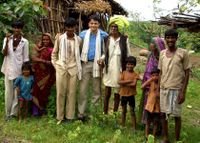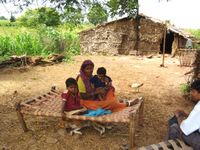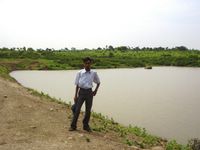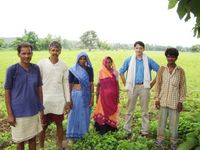Here is a mail that I wrote to members of IIFM Alumni (at yahoo groups) in September 2005 after Katrina struck some parts of US and horrifying images from New Orleans filled our living rooms through various News Channels.
Although this incidence was one of human suffering and tragedy, some sections of Indian Society tried to use this opportunity to draw comparisons between India and US; trying to prove that India is superior to the US - as we were able to address the floods in Mumbai in a better way the US Government did in case of Katrina. One such mail was forwarded in the forum.
I felt hurt with this opinion and wrote back to the forum my opinion about it. I had almost forgotten about this mail, when I recently saw it posted on the blog of one of my seniors from IIFM quoting my mail. I am reproducing the same here to make it a part of my blog on issues of development in India.
"Dear All,
This mail is in context of the recent comparisons drawn between US and India by certain sections of Indian society. Some of us agreed to that point of view and some did not. With this mail, I am trying to put in front of you my thoughts on this. I would like to request you not to view my thoughts as some kind of generalization. Our country is so vast that it is impossible to state a fact that applies true for each and every nook and corner of the country. Whatever I am expressing is based on my personal experiences as well as the information that I could gather from the newspapers, books and articles, as well as the experiences of my friends and colleagues working across India. Please feel free to disagree where ever you think I am wrong and point it out to me. I would be grateful for the same, as you would help me in getting over some of the number of imperfections that I have as an individual.
In the midst of all the development that has been happening, India scaling new heights in many fields, growing confidence of Indians, booming Indian economy (Sensex breaking the 8000 ceiling), new jobs and avenues that are being created, Indian IT professionals dominating the silicon valley, recent Goldman Sachs report of India being one of the economic superpowers in coming few years and our comparisons of the tragedies-Mumbai and New Orleans, there is a threat of us becoming complacent and start blowing our own trumpet while the world moves on. I don't have the slightest doubt about the capacities of us the Indians and the potential that our country has to become a non-belligerent, supportive superpower (unlike the US) in the days to come, but, in words of Robert Frost- '...miles to go before I sleep....'.
Disparity in Indian society is growing by the day and there is a total system failure in terms of the education, health, livelihoods and law and order in many parts of the country.
So, while many of us in past few years have been promoted from the Indian Railways to Jet Airways customers, there are still millions of our countrymen who don't have access to a pucca road on which they can travel to the nearest haat with their produce in their Ox-carts. While the galloping Indian economy in developed parts of the country treads on the six and eight lane highways, most parts of the country are still inaccessible for whole four or five months of the rains- unfortunately this is the time when the morbidity and mortality due to various diseases is at the peak and the people desperately try to reach the nearest block or town for medical assistance.
While we in metros see the vulgar display of wealth in terms of new longer and costlier cars, expensive consumer goods and shopping malls full of the best products of the world market, millions of our compatriots are still going without two square meals a day.
Bonded labour, in form of Harwaha system is still going on in our villages. So, for Rs.8000 a year (A year, mind you, not a month), it is still possible to have a dignified slave to work for you 14 hours a day in our villages. Most of the times, it is poorest of the poor SC and ST families of the village that get into the cob-web of this system.
While in our cosmopolitans, corporate hospitals like Max, Apollo and Escorts are coming up, in most of the rural areas it is the Quacks (Jhola Cchaaps), who are not qualified enough to treat animals are treating human beings for diseases ranging from common cold to cancer. I witnessed in one village of Madhya Pradesh of population 160, 15 people dying in one year, of which 11 were children below 15 years of age and 12 of the dead had died because of lack of safe drinking water.
With all hungaama in the name of IT in rural India, the farmer is being charged exorbitant amounts for getting a copy of his land records by the soochak of the Gyandoot Project in Madhya Pradesh. E-governance is still a distant dream for most of the districts in the country.
On two ends of the spectrum, NGO activists are either making wealth or are getting killed for their work and rapport with the community depending on the degree of integrity and honesty that they display. They are finding stiff resistance from the stablished players of the rural and urban development- government officials, and businessmen who are hand in gloves with the corrupt and inefficient Government machinery at many places.
Forests are vanishing, despite JFM, SFM and whatever Forest Management, many forest areas are rapidly turning to deserts. Our tigers and leopards are being poached at alarming rates to be sold in the international markets and danger of extinction is looming large on these magnificent animals. All this goes on while we are trying evade this reality by burying our heads under the sand like an ostrich.
Other natural resources are fast depleting- worst hit is water which is being recklessly pumped out in whichever areas it is still available. Land quality also is depleting due to the reckless use of fertilizers and pesticides in agriculture and improper management of organic matter disposal. People turning towards the cash crops for more and quick income have also got a bearing over this situation.
Governance has become a victim of politics, corruption and vested interests of individuals. While the numbers of management institutes and engineering colleges in India have gone up drastically in past few years and in some parts they have come up like mushrooms, churning out tens of thousands of engineers or managers (so called) a year in a single state, in many other parts of the country there are only two or three 8th pass persons in the whole village!
Atrocities on weaker sections of the society- the poor and women- is common in rural areas and in some ‘disturbed’ states of India, it has assumed dangerous proportions. All said and done, the persons from both of these categories are still being subjected to a second rate citizen treatment and this practice is continuing unabated in many parts of the country.
Separatist movements are going on in many parts of the country, with a lot of bloodshed and brutalities both by militants and security forces. This has support of many countries who don’t want to see a strong India and are ready to go to any extent to check the movement of Indian juggernaut in the direction of becoming a developed nation. Lack of development and prosperity in these areas are helping the separatist movement by providing a pretext of these movements to drag in the youth into this.
The crux is- there is no chance for our country to think that we have achieved what we wanted to achieve and relax, even for a minute. They say- ‘Rome was not built in a day’ and neither would be our country.
My intention is not to dampen the spirit of India emerging as a developed country. I am a total nobody to say this, considering all the big-wigs are going gaga about the achievements of the country in the recent years. All I want is to point that lets not get complacent with the achievements of our country so far. Let’s not start relaxing so early and start living in a false sense of well being, as all is not well.
If at all this is going to be a triumph for the nation, it is just the beginning. The fight has just started and a lot of struggle is ahead. There are millions of Indians waiting for their fair share in the development of the country. With the growing rhetoric about privatization and commercialization a panacea to all problems of the country, there is a chance of dumping this responsibility totally on the market forces (as we had done in past, dumping the total responsibility of development of the nation on the government and its agencies, and there by making them feel like God- all pervasive and omnipotent- without any answerability whatsoever). None of them- either the Government or the Market- would ever be able to single-handedly perform the Herculean task of the development of the multitudes of our country till the time we, the individuals assume a portion of this task as an individual responsibility and do our bit about addressing these problems.
And for this, the first thing that is required is a lot of soul searching and a well participated discussion amongst us, and to find out the exact role that we can play and how to optimize it in the favour of the Indian version of the Chinese Long March that we are witnessing. In a way, we are in middle of making of the history- emergence of the modern India as a developed country. It is akin to the freedom movement and as we ask our previous generations, tomorrow’s generations are going to question us how we participated in this process and what role we played in this. Victory or defeat-in both cases, we would be responsible for some role or the other. It’s now up to us, what we want to be- performers, or the fence sitters.
I would like to quote Late Dushyant Kumar, one of the famous Hindi poets of modern times before I close.
‘Ho chuki hai peer parvat si, pighalni chahiye/
Is Himalay se koi Ganga nikalni chahiye/
Sirf hungama khada karma mera maksad nahin/
Mera maksad hai ki koi tadbir nikalni chahiye/
Mere sine mein nahin to tere seene mein sahi/
Ho kahin bhi aag, lekin aag jalni chahiye……"









